Plant Phenotyping Market Size
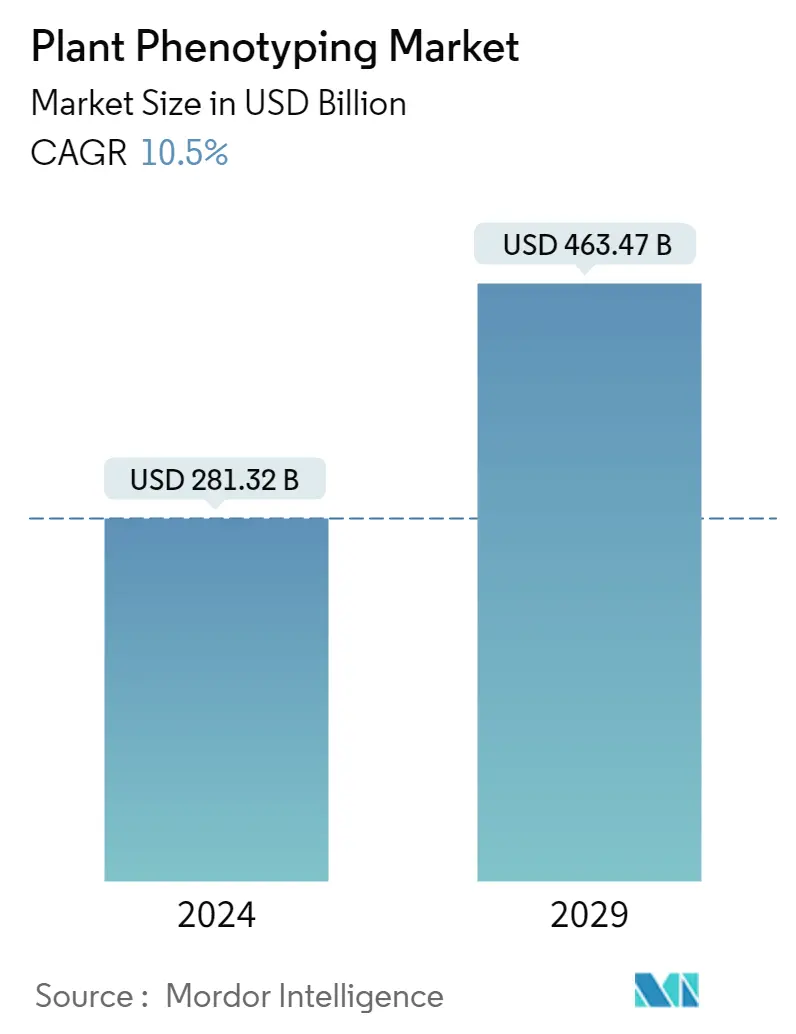
| Study Period | 2019 - 2029 |
| Market Size (2024) | USD 281.32 Billion |
| Market Size (2029) | USD 463.47 Billion |
| CAGR (2024 - 2029) | 10.50 % |
| Fastest Growing Market | Asia Pacific |
| Largest Market | Europe |
Major Players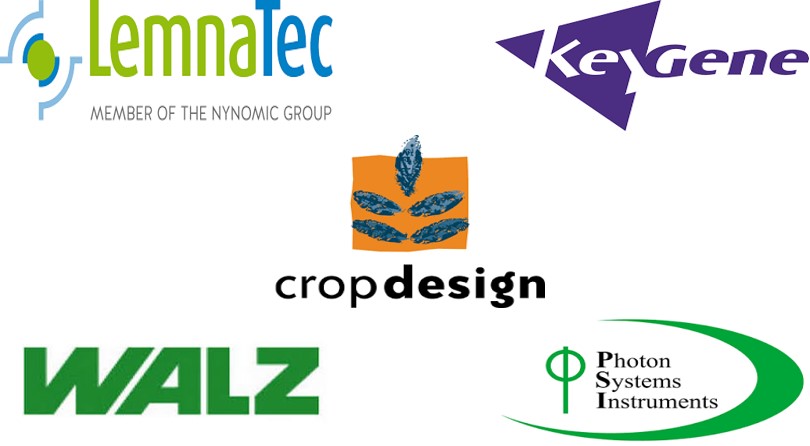
*Disclaimer: Major Players sorted in no particular order |
Plant Phenotyping Market Analysis
The Plant Phenotyping Market size is estimated at USD 281.32 billion in 2024, and is expected to reach USD 463.47 billion by 2029, growing at a CAGR of 10.5% during the forecast period (2024-2029).
The increasing population has driven the need to grow high-yielding crops for the fulfillment of food security needs, which in turn is boosting the demand for innovative plant breeding techniques for improved crop productivity. High frequency of extreme weather conditions and global warming are also enhancing the need for crop productivity across the world which is favoring the phenotyping market. The market is dominated by the European region.
Furthermore, the innovations in imaging techniques facilitate the better assessment of plant characteristics for the development of better crop breeds suitable for the particular environment. Imaging techniques assist in detecting optical properties of plants by using various technologies like imaging spectroscopy, infrared imaging, fluorescence imaging, and visible light imaging, whose, data sorts from macroscopic to molecular scale.
Plant Phenotyping Market Trends
This section covers the major market trends shaping the Plant Phenotyping Market according to our research experts:
Increasing Number of Seed Borne Diseases is Driving the Market
Almost 90% of all the world's food crops are grown from seeds that are widely distributed in national trade and international trade. Germplasm is also distributed and exchanged in the form of seeds in breeding programs. However, many plant pathogens can be seed transmitted and seed distribution is a very efficient form of plant disease dispersal. Under suitable environmental conditions, disease-causing organisms that are carried by seeds may be transmitted to cause disease in developing seedlings or plants. The pathogen attacks the germinating seedling and affects the seedling establishment, with others, disease symptoms are not seen until a later stage of growth. With the rising number of seed diseases that are affecting crop productivity, it has become necessary to adopt techniques like plant phenotyping to eliminate them and propagate better and disease-free crop varieties. Hence, the market is increasingly been driven by the outbreak of plant diseases in cereals, fruits, vegetables, oilseeds and other crops across the world.
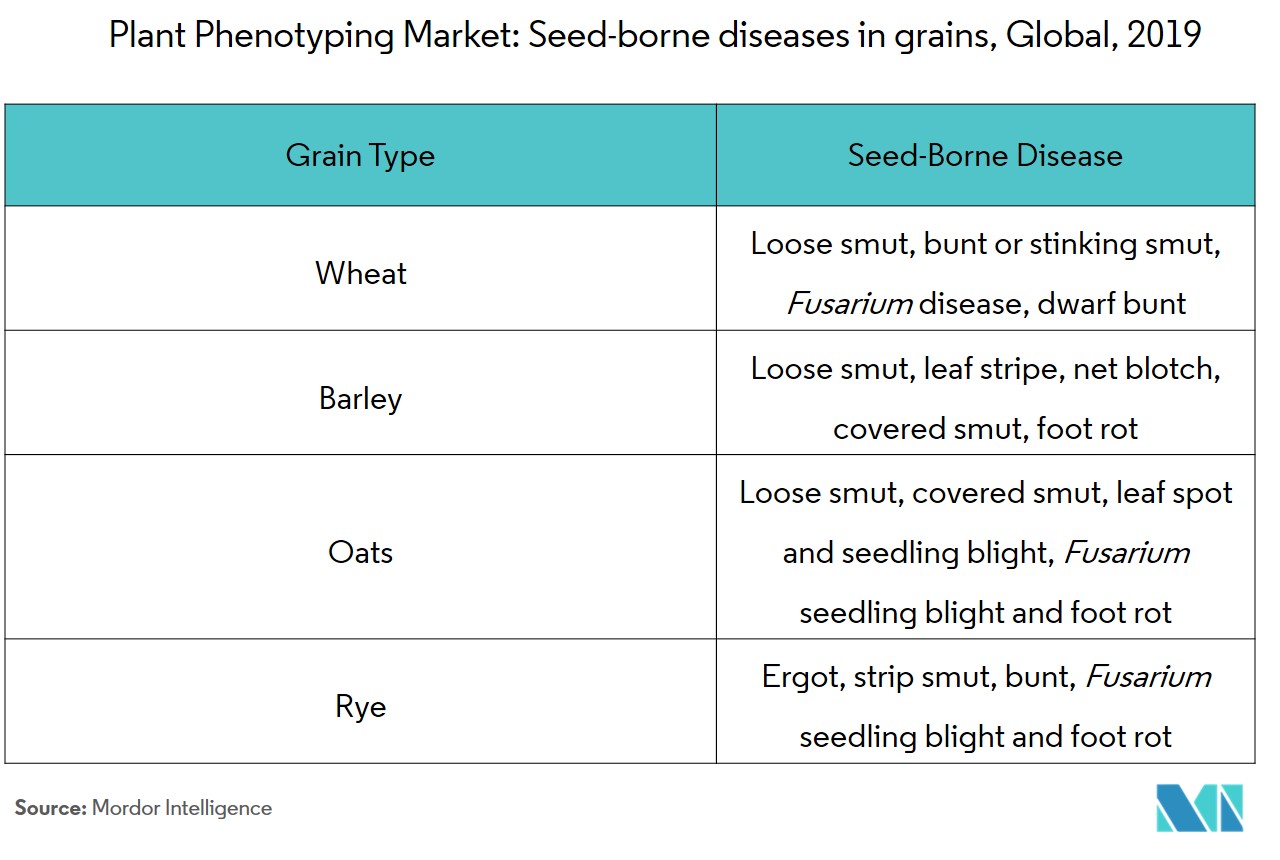
Europe Dominates the Phenotyping Market
Europe accounted for the largest share of the plant phenotyping market in 2019. High emphasis on the funding of plant phenotyping experiments from governments and other organizations in Europe and North America has played a vital role in the growth of the plant phenotyping market in these regions. Additionally, key players in the plant phenotyping market are located in the European region, which makes it the dominant market with effective phenotyping research and services over other regions. There is a rising number of research activities taking place across the European countries which are driving awareness and in turn the market for plant phenotyping products and services. In 2019, a study conducted in Europe established that the Mediterranean climate in the countries of Italy, Greece, Portugal, and Spain with hot dry summers and frequent droughts alongside the heterogeneous panorama of phenotyping within Mediterranean countries, describing the state of the art of agricultural production, breeding initiatives, and phenotyping capabilities, drive the market in the region.
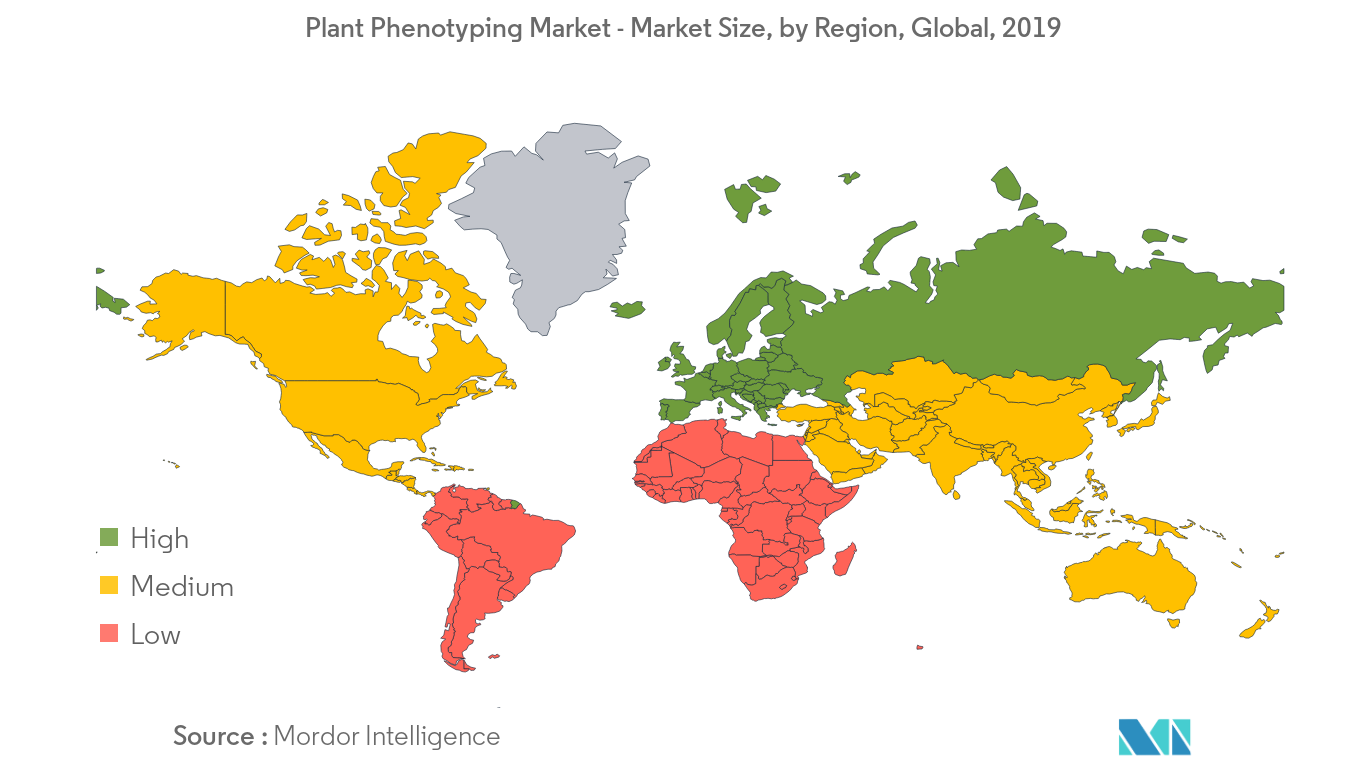
Plant Phenotyping Industry Overview
The plant phenotyping market is consolidated and is dominated by a few major players likeLemnaTec, CropDesign - BASF SE, Heinz Walz, Photon Systems Instruments, Qubit Systems, and KeyGene.The market is characterized by a high degree of competition and the companies are increasingly investing in product launches, mergers & acquisitions,collaborations, and expansions to keep ahead of the competition. For example, in 2018,BASF (CropDesign) openeda global state-of-the-art breeding center for cucumbers in Nunhem,housing all cucumber pre-breeding and breeding programs in Nunhem: high wire, long, short, snack, and pickling cucumber types, including the phenotyping line which offers digital evaluation of fruit characteristics.Furthermore, CropDesign engineers are also developing novel sensors for monitoring plant growth or soil quality, which can be readily linked to in-house developed, user-friendly apps.
Plant Phenotyping Market Leaders
-
LemnaTec GmbH
-
BASF SE (Crop Design)
-
Heinz Walz GmbH
-
Keygene
-
PSI (Photon Systems Instruments)
*Disclaimer: Major Players sorted in no particular order
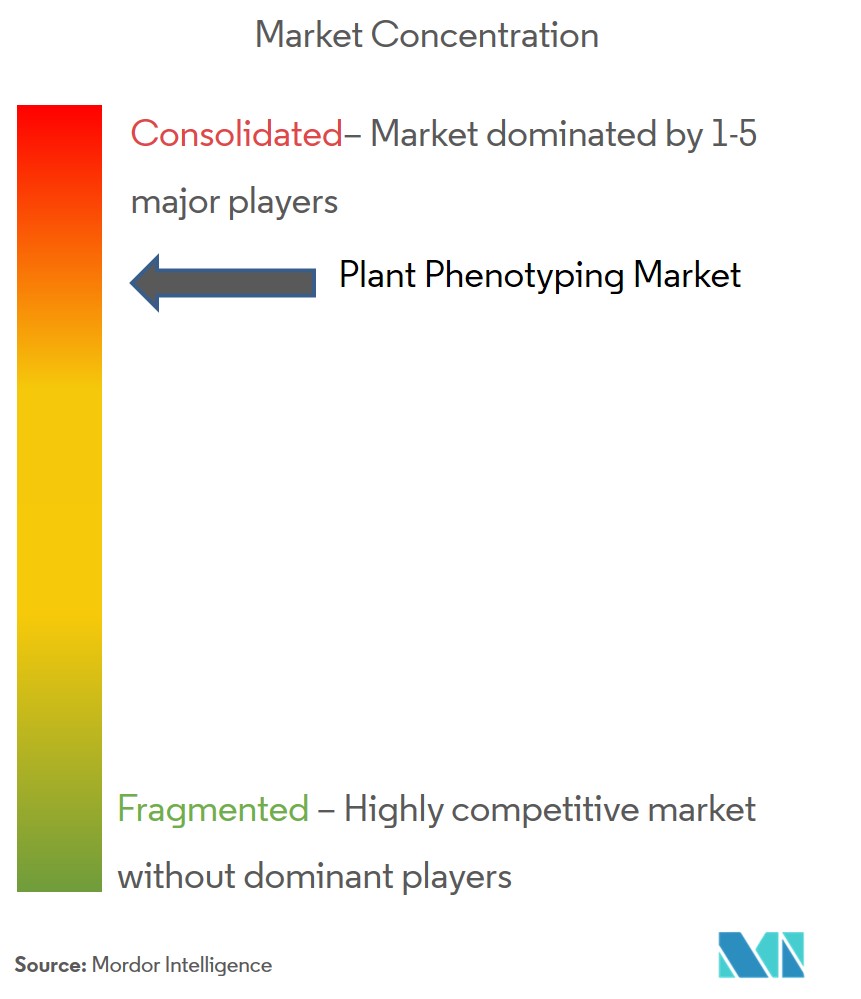
Plant Phenotyping Market Report - Table of Contents
1. INTRODUCTION
- 1.1 Study Deliverables
- 1.2 Study Assumptions
- 1.3 Scope of the Study
2. RESEARCH METHODOLOGY
3. EXECUTIVE SUMMARY
4. MARKET DYNAMICS
- 4.1 Market Overview
- 4.2 Market Drivers
- 4.3 Market Restraints
-
4.4 Porter's Five Force Analysis
- 4.4.1 Threat of New Entrants
- 4.4.2 Bargaining Power of Buyers
- 4.4.3 Bargaining Power of Suppliers
- 4.4.4 Threat of Substitute Products
- 4.4.5 Competitive Rivalry
5. MARKET SEGMENTATION
-
5.1 Products
- 5.1.1 Equipment
- 5.1.1.1 By Automation Type
- 5.1.1.1.1 Manual
- 5.1.1.1.2 Semi-Automated
- 5.1.1.1.3 Fully Automated
- 5.1.1.2 By Application
- 5.1.1.2.1 High-Throughput Screening
- 5.1.1.2.2 Trait Identification
- 5.1.1.2.3 Photosynthetic Performance
- 5.1.1.2.4 Morphology and Growth Assessment
- 5.1.1.2.5 Other Applications
- 5.1.1.3 By Analysis System
- 5.1.1.3.1 Image Analysis Systems
- 5.1.1.3.2 Multispectral Scientific Cameras
- 5.1.1.3.3 Canopy Analysis Systems
- 5.1.1.3.4 Fluorometers
- 5.1.1.3.5 Others
- 5.1.1.4 By Site
- 5.1.1.4.1 Laboatory
- 5.1.1.4.2 Green House
- 5.1.1.4.3 Field
- 5.1.1.5 By Platform
- 5.1.1.5.1 Conveyor-Based/Modular Systems
- 5.1.1.5.2 Bench-Based Systems
- 5.1.1.5.3 Handheld/Portable Systems
- 5.1.1.5.4 Drones
- 5.1.2 Softwares
- 5.1.2.1 Image Analysis
- 5.1.2.2 Data Acquisition
- 5.1.2.3 System Control
- 5.1.2.4 Other Softwares
- 5.1.3 Sensors
- 5.1.3.1 Image Sensors
- 5.1.3.2 NDVI Sensors
- 5.1.3.3 Temperature Sensors
- 5.1.3.4 Other Sensors
-
5.2 Services
- 5.2.1 Measurement Acquisition & Data Analysis
- 5.2.2 Statistical Analysis
-
5.3 Geography
- 5.3.1 North America
- 5.3.1.1 United States
- 5.3.1.2 Canada
- 5.3.1.3 Mexico
- 5.3.1.4 Rest of North America
- 5.3.2 Europe
- 5.3.2.1 Germany
- 5.3.2.2 United Kingdom
- 5.3.2.3 France
- 5.3.2.4 Italy
- 5.3.2.5 Russia
- 5.3.2.6 Spain
- 5.3.2.7 Rest of Europe
- 5.3.3 Asia Pacific
- 5.3.3.1 China
- 5.3.3.2 Japan
- 5.3.3.3 India
- 5.3.3.4 Australia
- 5.3.3.5 Rest of Asia-Pacific
- 5.3.4 South America
- 5.3.4.1 Brazil
- 5.3.4.2 Argentina
- 5.3.4.3 Rest of South America
- 5.3.5 Africa
- 5.3.5.1 South Africa
- 5.3.5.2 Rest of Africa
6. COMPETITIVE LANDSCAPE
- 6.1 Most Adopted Strategies
- 6.2 Market Share Analysis
-
6.3 Company Profiles
- 6.3.1 BASF SE (Crop Design)
- 6.3.2 Delta-T Devices
- 6.3.3 Heinz Walz GmbH
- 6.3.4 Keygene
- 6.3.5 LemnaTec GmbH
- 6.3.6 Phenomix
- 6.3.7 Phenospex
- 6.3.8 PSI (Photon Systems Instruments)
- 6.3.9 Qubit Systems
- 6.3.10 Rothamsted Research
- 6.3.11 The Vienna Biocenter Core Facilities
- 6.3.12 WPS
- *List Not Exhaustive
7. MARKET OPPORTUNITIES AND FUTURE TRENDS
** Subject To AvailablityPlant Phenotyping Industry Segmentation
Plant phenotyping is an emerging scientific technique that links genomics with plant agronomy. In the process of phenotyping, the functional plant body or phenotype is formed during plant growth and development from the dynamic interaction between the genetic background or genotype and the physical world in which plants develop or the environment.
A phenotype refers to the composite of an organism’s observable characteristics or traits, such as its morphology, development, biochemical or physiological properties, behavior, and products of behavior. A phenotype is a result produced by the expression of an organism’s genetic code or genotype, as well as the influence of environmental factors and the interactions between the two. The basic use of plant phenotyping is to gain knowledge of various plant attributes and to utilize it for production of crops with higher productivity and sustainability.
| Products | Equipment | By Automation Type | Manual |
| Semi-Automated | |||
| Fully Automated | |||
| Products | Equipment | By Application | High-Throughput Screening |
| Trait Identification | |||
| Photosynthetic Performance | |||
| Morphology and Growth Assessment | |||
| Other Applications | |||
| Products | Equipment | By Analysis System | Image Analysis Systems |
| Multispectral Scientific Cameras | |||
| Canopy Analysis Systems | |||
| Fluorometers | |||
| Others | |||
| Products | Equipment | By Site | Laboatory |
| Green House | |||
| Field | |||
| Products | Equipment | By Platform | Conveyor-Based/Modular Systems |
| Bench-Based Systems | |||
| Handheld/Portable Systems | |||
| Drones | |||
| Products | Softwares | Image Analysis | |
| Data Acquisition | |||
| System Control | |||
| Other Softwares | |||
| Products | Sensors | Image Sensors | |
| NDVI Sensors | |||
| Temperature Sensors | |||
| Other Sensors | |||
| Services | Measurement Acquisition & Data Analysis | ||
| Statistical Analysis | |||
| Geography | North America | United States | |
| Canada | |||
| Mexico | |||
| Rest of North America | |||
| Geography | Europe | Germany | |
| United Kingdom | |||
| France | |||
| Italy | |||
| Russia | |||
| Spain | |||
| Rest of Europe | |||
| Geography | Asia Pacific | China | |
| Japan | |||
| India | |||
| Australia | |||
| Rest of Asia-Pacific | |||
| Geography | South America | Brazil | |
| Argentina | |||
| Rest of South America | |||
| Geography | Africa | South Africa | |
| Rest of Africa |
Plant Phenotyping Market Research FAQs
How big is the Plant Phenotyping Market?
The Plant Phenotyping Market size is expected to reach USD 281.32 billion in 2024 and grow at a CAGR of 10.5% to reach USD 463.47 billion by 2029.
What is the current Plant Phenotyping Market size?
In 2024, the Plant Phenotyping Market size is expected to reach USD 281.32 billion.
Who are the key players in Plant Phenotyping Market?
LemnaTec GmbH, BASF SE (Crop Design), Heinz Walz GmbH, Keygene and PSI (Photon Systems Instruments) are the major companies operating in the Plant Phenotyping Market.
Which is the fastest growing region in Plant Phenotyping Market?
Asia Pacific is estimated to grow at the highest CAGR over the forecast period (2024-2029).
Which region has the biggest share in Plant Phenotyping Market?
In 2024, the Europe accounts for the largest market share in Plant Phenotyping Market.
What years does this Plant Phenotyping Market cover, and what was the market size in 2023?
In 2023, the Plant Phenotyping Market size was estimated at USD 254.59 billion. The report covers the Plant Phenotyping Market historical market size for years: 2019, 2020, 2021, 2022 and 2023. The report also forecasts the Plant Phenotyping Market size for years: 2024, 2025, 2026, 2027, 2028 and 2029.
Plant Phenotyping Industry Report
Statistics for the 2024 Plant Phenotyping market share, size and revenue growth rate, created by Mordor Intelligence™ Industry Reports. Plant Phenotyping analysis includes a market forecast outlook to 2029 and historical overview. Get a sample of this industry analysis as a free report PDF download.



